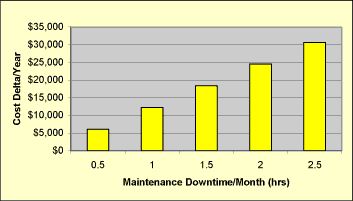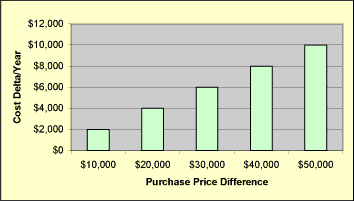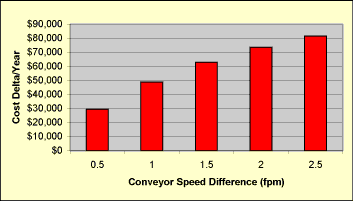2005 Articles
Recognizing the Real Cost of Equipment Ownership
A new model for comparing inline aqueous cleaning systems has yielded annual six-figure savings.
Manufacturers that keep a sharp eye on the bottom line know that the cost of ownership and operation of a piece of capital equipment is actually more important, when considered over the span of the useful life of the equipment, than the initial investment in the machine. Operational costs can vary widely between different systems designed to do the same job at similar capacities, and these differences can be tens of thousands of dollars. The key is to identify the most significant operating costs of the equipment, obtain accurate data on each machine and compare the differential cost impact of each prior to making a purchasing decision. For some machines, cycle time performance may be the only significant factor. For others, it may be facility dependent; e.g., in terms of electrical, water or nitrogen consumption. Use of consumables, such as chemicals, filters and other supplies, as well as required maintenance and mean time between failures (MTBF) are also important cost factors.
A number of factors can have a significant effect on cost of ownership. Consider a case in which 1,000 boards per day must be processed. One machine has a conveyor speed of 2 ft. per minute and the other 4 fpm. Assuming 12" spacing, the first machine will need 8.33 hrs. to accomplish the task, the second needs only half the time (4.16 hrs). The obvious impact is that the first machine will double the associated labor cost (if it requires a machine operator) and it can potentially create the need to run a second shift if production requirements increase. An additional, and often overlooked, impact is the cost of running the machine. Production machines, such as reflow or wave soldering systems, or aqueous cleaners, require tremendous amounts of electricity. In addition, water, process chemicals or industrial gases may be needed. A machine that must run twice as long to meet production demands will have significantly higher daily operating costs. Multiply that over a typical 250-day production year and the cost of ownership impact quickly minimizes capital cost differences.
Traditionally, capital equipment cost justification involved ROI analysis that would compare projected cost savings to capital cost. The accounting profession has done an admirable job of creating discounted cash flow models, depreciation tools and tax implication scenarios. Unfortunately, these tools provide great detail on the investment side, but do not provide an efficient means to calculate the cost-savings side. Too often, the savings projected with a capital equipment purchase are based on only one or two factors, such as cycle time or conveyor speed, because of the ease in calculation. Accurate cost savings must be measured as part of overall cost of ownership. The issue at hand is to determine what analysis by the manufacturing engineer can provide reasonable quantitative information without requiring excessive time gathering data.
Several models are available with varying degrees of complexity. At one end of the spectrum are basic ROI analysis tools; at the other end are models so in-depth and complex that the value of their information becomes suspect because of the preparation time involved and the inevitable diminished accuracy associated with a large number of variables. Because most of the data involved with these analyses is “projected,” an inherent amount of error exists. Cumulative inaccuracies can eventually outweigh the potential benefits of including the data. The key is to use a model that provides enough data to make an informed decision without being so cumbersome as to diminish its worth.
In attempting to quantify cost of ownership, it is helpful to break the analysis down into three or four significant areas. Certainly capital cost must be included; other factors might include performance (productivity), facilities cost and maintenance cost. The level of detail in each area should be proportional to the amount and accuracy of data available and to the magnitude of the project. A million-dollar investment justifies a greater level of detail than an investment of $20,000. Capital cost should include the price of the machine and any related installation costs. The performance component should include significant factors associated with the machine’s productivity. Possibilities include cycle time, conveyor speed, yield, elimination (or addition) of secondary operations, and use of consumables. Facility costs might include electric/water/air consumption rates and cost of floorspace. Maintenance costs can be difficult to project, but MTBF and mean time to repair (MTTR) should be used if data are available. Similarly, a review of the machine’s operating manual should be done to estimate frequency and duration of routine maintenance. A machine that shuts down production once a week for required maintenance has a higher cost of ownership than one that does so quarterly. Regardless of the factors used, a spreadsheet provides a good format for analysis and side-by-side comparison of equipment.
A model has recently been developed to evaluate cost of ownership for inline aqueous cleaning systems. While somewhat specific to the product, the principles are applicable to a range of capital equipment. The model was created after several field case studies proved that operating cost factors were clearly more significant than minor differences in capital cost.
A leading global EMS realized operational cost savings at one facility of over $125,000 per year by eliminating secondary board drying operations and improving test yields. In addition, it saved another $100,000 per year through reductions in electrical, deionized water and wash chemical usage compared with their previous machine.
Similarly, a major, multi-plant OEM is experiencing significant cost savings in wash chemistry. At a Texas facility, a manufacturer is using six gallons less per day than with their previous cleaner. At approximately $50 per gallon, its six-day/week production operation realizes savings of over $90,000 per year. And at a New England facility, one end-user is achieving a 400% reduction in wash chemistry, resulting in yearly savings of over $100,000.
This tool analyzes the difference in cost of ownership between two machines, which can be useful in the decision making process. Figure 1 shows the relatively insignificant yearly cost difference between machines with a $10,000 to $50,000 difference in purchase price (using straight line depreciation over five years). More significant is the yearly cost impact derived from conveyor speed differences of 0.5 to 2.5 fpm. Conveyor speeds considered ranged from 2 to 4.5 fpm. With a fixed requirement of 2,000 boards per day, slower conveyor speeds dictate more machine run time, increasing electrical, water, chemical and labor costs. Greater run time will also increase both routine maintenance and repair costs. Figure 2 shows the escalation in differential cost as conveyor speed differences increase.
|
Figure 3 shows a range of differential costs for routine monthly maintenance in 0.5 hr. increments. The baseline cost assumes $25/hr. cost for a maintenance technician and $1,000/hr. opportunity cost to shut down the line. Even with that conservative shutdown cost, the difference in CoO between two machines with varying routine maintenance requirements is significant.
 FIGURE 3: Differential maintenance cost. |
When evaluating the cost of ownership of an aqueous cleaning system, differences in water, wash chemistry and electrical consumption are extremely important. These differences are magnified when one machine has a conveyor speed advantage over another, because the machine with the slower speed will have to run more hours (and use more water, chemicals and electricity) to achieve the same levels of production. When these costs are quantified, they will typically overshadow differences in initial capital cost.
While the numbers presented here are somewhat specific to aqueous cleaning, the overall cost of ownership concept can be easily adapted to other types of capital equipment. Productivity, operating costs and maintenance requirements must be considered to accurately assess the impact of a machine purchase. It is this evaluation of CoO, as opposed to just capital cost, that is relevant.
Shean R. Dalton is president of Austin American Technology Corp.; sdalton@aat-corp.com.






